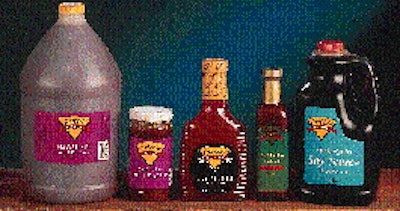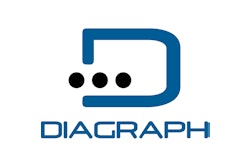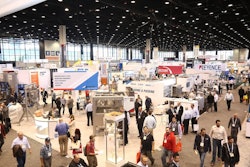When a company grows 25% annually for several years running, a packaging operation that's only partially automated can become a real liability. Just ask plant manager Eric Rinearson at Yoshida Food Products in Portland, OR, where gourmet cooking sauces are bottled and shipped nationwide and to export markets in Europe, Japan, Korea, and the Philippines. "We used to wheel bottles in by pallet load and a worker would unload them by hand and place them on the filler infeed conveyor," says Rinearson. "We case-packed by hand as well." That started to change in May of 1994, when manual case packing was taken over by an automatic case packer from Hartness (Greenville, SC). Then in the summer of 1995 the firm continued its equipment upgrade by installing a new uncaser, debagger, rinser, filler, capper, metal detector, checkweigher, induction sealer and labeler. The net result is a packaging line capable of a steady output of 150 bottles/min, up from 40/min before the new line was installed. Just as important as improved filling speeds is the flexibility the firm designed into the new line. Requiring just four operators, it handles plastic or glass, handled or unhandled, oval, square or round containers, and fills from 9 oz to as much as a gallon. And despite the wide variety, the same 150-bpm speeds are attained for all bottles except the 1-gal size. These are filled at 75/min. Visiting the shows The first step in designing such a line, says Rinearson, was getting out to some packaging shows to see what machinery manufacturers had to offer. (It was at Pack Expo West in Las Vegas, as a matter of fact, that PW editors first met Rinearson.) From the start, flexibility was what he was hunting for. "The need for flexibility is one reason we settled on the Hartness case packer," says Rinearson. "It handles a wide variety of bottles and shapes. Right now we run 12 different bottles, and we're looking at a couple of new ones." Each time a new package is added, the necessary operating parameters, things like conveyors or pump speeds, are arrived at by trial and error. Once determined, that information is entered into the Allen-Bradley (Milwaukee, WI) SLC 5/03 PLC at the filler, which is networked via Allen-Bradley software to the PLCs controlling other equipment on the line. Thanks to the PLCs and the network that links them, subsequent changeovers to that package can be done largely on the touch-screen control panel at the filler. By selecting options from a menu on the screen, an operator communicates not only with the filler, but with PLCs on equipment upstream and downstream as well. It isn't only during changeover that the line's control system comes in handy. "The conveyors run at variable speeds," says Rinearson. "The individual machines are interlocked with sensors that convey information up and down the line. The PLCs receive this information and, through ladder logic software, control container speeds at all points." Uncase vs. debag Glass bottles enter the Yoshida line by means of an automatic uncaser. High-density polyethylene bottles, on the other hand, are debagged semi-automatically. All the operator does is place a layer of bagged bottles on a sweep platform; he then slits the bag and removes it. Bottles are swept onto a tabletop conveyor leading to a right angle exchange onto a single-file takeaway conveyor. Whether plastic from bags or glass from reshippers, bottles enter the filling room and immediately run through a water rinser. Filling is next, done on a U.S. Bottlers (Charlotte, NC) rotary pressure/gravity filler with 32 nozzles. Changeover from one size to another is accomplished in about three minutes, says Rinearson. "All that's involved are two knobs, a starwheel, a timing screw and a crank that raises or lowers the nozzles all in unison," he adds. "We try to run the same sauce all day," Rinearson continues. By "all day" he means one 10-hour shift. "We try to minimize bottle changes as well, though if we need to we can change bottles and be running in about an hour." The most popular bottle, says Rinearson, is the 1/2-gal handled HDPE jug. All of Yoshida's products are filled warm, and the highest target temperature is 165° F. As long as the target temperature is hit, the HDPE bottles hold up fine. But if filling temperatures creep up a bit, some deformation is possible, so Rinearson and crew must keep a close watch. The situation should be greatly improved later this year when a cooling tunnel is inserted into the line immediately after the filler. Following a four-spindle in-line capper from Pack West Machinery (Baldwin Park, CA), bottles make a U-turn and run through a metal detector and checkweigher supplied by Ramsey (Minneapolis, MN). Tamper-evident shrink banding is next; it will be reconfigured soon, says Rinearson, as a new applicator and heat tunnel are on the way. Pressure-sensitive labeling follows shrink-banding, though not before an Enercon (Menomonee Falls, WI) system induction-seals a foil liner to the bottle finish of all plastic bottles. Glass bottles, on the other hand, receive caps fitted with pressure-sensitive inner seals. Dual-infeed spacer belts Bottles enter the labeler, supplied by Labeling Systems Inc. (Mahwah, NJ), via dual-infeed spacer belts. More adjustable than feed screw/star wheel infeeds, the spacer belts are well-suited to Yoshida's many bottle sizes and shapes. The belts adjust in or out by means of a hand crank. Settings are based on numerical values, so returning to a specific bottle size is a matter of looking up the proper number rather than "eyeballing" or measuring each time. "Not only does the labeler do front-and-back, full wrap, round bottles, or square bottles, it's also brought a big improvement in labeling accuracy," says Rinearson. "Even on the square bottles, which are the toughest of all." That's the bottle that gets the full-wrap label, he explains, and getting an even wrap while assuring a smooth overlap in the back is a bit tricky. Rinearson says he made sure LSI was aware of this challenge from the outset. Then, he adds, "I let them worry about it." Bottles exiting the labeler pass an Imaje (Kennesaw, GA) ink-jet coder that marks production data on the labels. Then bottles leave the filling room and return by conveyor to the decasing and debagging room. There a Hartness drop packer returns them to the reshippers they arrived in or places them in display shippers fed by an automatic case erector that Rinearson bought from a used machinery source. Mounted on opposite sides of the discharge of the drop packer are two pairs of printheads belonging to a Diagraph (Earth City, MO) ink-jet system. A mechanical stop on one side of the conveyor turns the case 90° immediately after the first pair of printheads have made their mark. Then the second pair imprints the two sides missed by the first pair. Not all customers, says Rinearson, require four-side case coding, but for those that do, the four printheads come in handy. Following the case packing operation are case taping, palletizing and pallet stretchwrapping, all performed on machines Yoshida has had for some time. Replacements for these will be evaluated, says Rinearson, over the course of the year. In the meantime, Yoshida appreciates the benefits of the $1 million it spent in 1995 in its efforts to improve its bottling line.



































